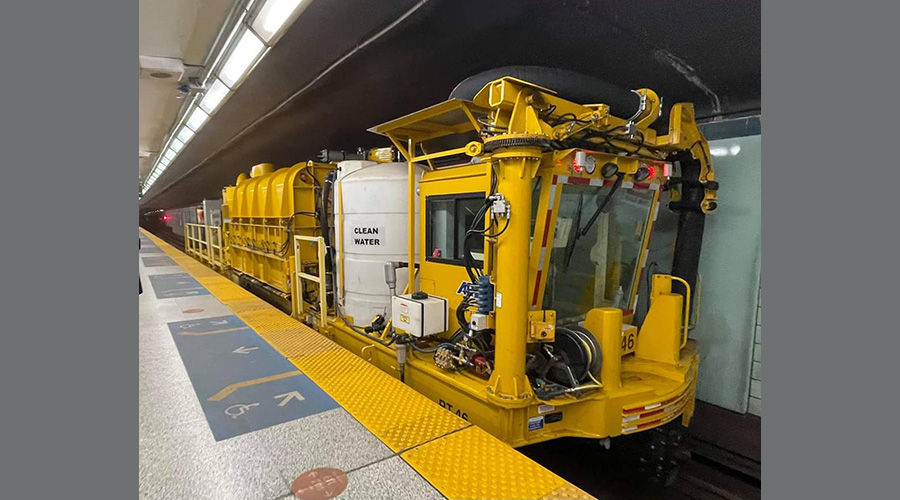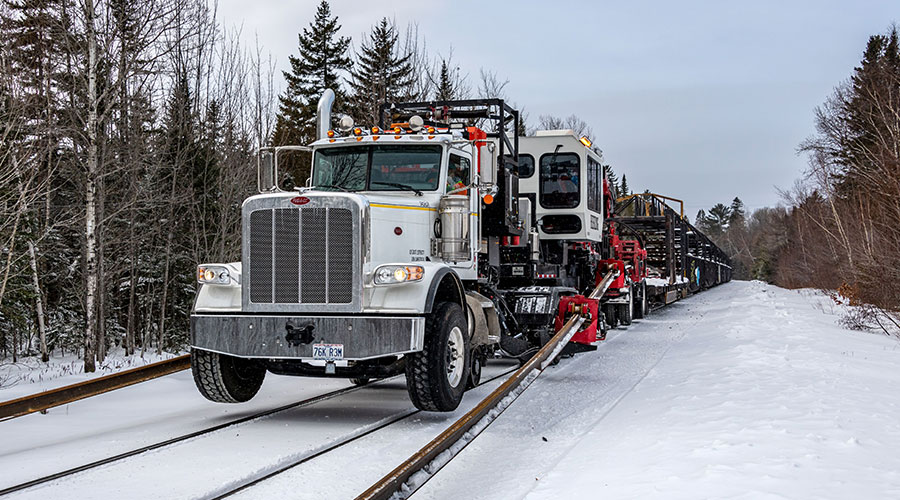Stay updated on news, articles and information for the rail industry
March 2011
Rail News: MOW
Maintenance of way: Special trackwork
Compiled by Walter Weart
The North American economy continues to recover, and railroads continue to record carload and intermodal volume increases. In the meantime, railroad engineering officials have rolled up their sleeves to begin work on what's likely to be a busy year on the maintenance-of-way front. Potentially, that's good news for the firms that produce an array of special trackwork components — from switches and switch points to frogs to "smart" ties.
Last month, Progressive Railroading checked in with several suppliers for their respective takes on current marketplace conditions, and recent product introductions, field tests and research ventures. Responses from four suppliers follow.
Cleveland Track Material Inc.
What are railroads looking for these days from their special trackwork suppliers?
"Some of the railroads have expressed interest in higher operating speeds that are provided with various versions of tangential geometries," said Jim Remington, vice president of engineering for Cleveland Track Materials Inc. (CTM), via e-mail. "As always, they are looking for products with lower maintenance requirements and longer life cycles. The continued emphasis is still on standardization along with price and delivery clearly being the top priority as it has been for many years."
Acquired three years ago by Vossloh AG, CTM is part of Vossloh's Switch Systems Division.
"New products have resulted from this new corporate structure and existing products are now available to others in the Vossloh family," Remington said. "Asymmetrical switch points are one offering that has resulted from this and offer unique advantages over conventional points, and we have supplied these to PATH as they have some unusual requirements, including a very flat turnout radius."
The 54E1A1 point section is a short, stubby section that is rolled in Europe with an asymmetrical flange profile, a thick web and with a substantial head. The point rides on raised chairs and rollers for ease of movement. The heel end of the point also is forged to match and flash-butt welded to the running rail.
Another product courtesy of the new corporate structure is a Monoblock Flash Butt Welded Frog — a "single piece from our sister company Amuirro, located in Spain, which means that there are no bolt hole cracks and no headlocks," Remington said.
Two other products — Cast Roller and Slide Chair Plates — are used in connection with switches provided by Vossloh Cogifer in France. Neither product requires lubrication or braces, a significant factor when used with turnouts in connection with high-speed freight and passenger trains, Remington said.
CTM also has developed a new application for pre-plated extended machine gage plate assemblies and retrofit frog gage plate packages.
"Working with the Norfolk Southern, we have developed special gage plates, which we pre-plate to ties for them," said Remington, adding that CTM examined the old Southern and Norfolk & Western plates and developed a compromise plate that reduced the number of components. "We also developed a stocking program for the NS to further work with them in this area."
Progress Rail Services
At Progress Rail Services, "improving life-cycle cost management for our customers is an ongoing objective," said Scot Campbell, Progress Rail Services' national sales manager – trackwork, via e-mail. "We continually look to improve our existing products, as well as introduce new ones."
As examples, Campbell cited the moveable point frog used in heavy tonnage coal lines and high-speed rail applications in the company's One-Way Low Speed, and a lift frog for use with low-volume sidings.
"We incorporated our taper rail connection for rail to manganese castings in most all of our railbound manganese frogs, spring frogs and even our crossing designs," he said. "This connection nearly eliminates impacts when the wheel transverses this mechanical joint connection."
Progress Rail also offers its flash-butt welded frog designs with rail welded to the casting intended for those who "want the mechanical joint eliminated," Campbell said.
"Along with the taper or welded joint, Progress has standardized the conformal top frog by machining the top surface to the same taper as the AAR wheel," he added. "Testing at TTCI in Pueblo [Colo.] has proven this feature reduces impacts when the wheel crosses the open flangeway."
As for product improvements or enhancements: Progress Rail officials have witnessed "positive results" from the company's initial full flange bearing crossing, Campbell said. Based on observations and wear material testing during two and one-half years of service, Progress Rail has made improvements that "should greatly extend the life of crossing diamonds," he added.
"While we believe flange bearing technology is in its infancy, we have developed a partial flange bearing yard frog that, along with the taper rail connections, will reduce wheel impacts," Campbell said. "This is not only beneficial for the track structure, but for the rolling equipment, as well."
Although most of the maintenance occurs in the frog area of a turnout and at grade crossing diamonds, Progress Rail officials have reviewed switch point machining to increase the product's life cycle, Campbell said. "We performed some work on our own in addition to working with TTCI to bring prototype designs to life," he added. "We have also recently developed an economical in-plate roller system for switches that will be in track soon and added a non-steel switch rod to our product list."
Unitrac Railroad Materials Inc.
So far, officials at Unitrac Railroad Materials Inc., a specialty trackwork manufacturer and distributor of new and relay rail, feel pretty good about 2011's prospects.
"Although revenue held steady in trackwork orders during the last couple of years, 2009 and 2010 proved to be a difficult two-year period," said Phil Pietrandrea, senior vice president of sales and marketing, via e-mail. "However, 2011 started right out of the gate to show some positive signs due to a variety of funded projects that seem to be moving forward."
Although the company hasn't added to its product lines recently, it continues to improve production procedures while focusing on enhancing product quality, Pietrandrea said. The focus appears to be paying off.
"Class I railroads have been purchasing panelized turnouts for a number of years, but it seems more and more transit authorities, regional and short-line railroads have embraced the idea of receiving panelized turnouts," Pietrandrea said. "Unitrac has provided this service to our customers for a number of years and we see growth in this area as a result of our proficiency."
VAE Nortrak North America Inc.
Railroads continue to seek ways to squeeze the maximum possible value from their infrastructure investments. They also aim to minimize maintenance workloads. As a result, officials at VAE Nortrak North America Inc. are "seeing greater interest in ‘premium' product lines," said Chief Technical Officer Brian Abbott via e-mail.
Nortrak's premium welded frogs — both welded boltless manganese and welded spring manganese — are designed to eliminate the bolted joints typical of conventional RBM and spring frogs. The result is reduced dynamic loading and maintenance, and greatly improved product life, Abbott said. Another marketplace development: the growing importance of Buy America regulations.
"Federal funding of key rail infrastructure projects such as Chicago's CREATE and the speed enhancement of joint access corridors (e.g., Chicago-to-St. Louis) dictate the selection of U.S. domestic material," Abbott said, adding that Nortrak is a fully integrated supplier of track systems and "uniquely positioned" to help roads ensure they are Buy America compliant.
Nortrak also continues to develop new products, including SFTPro™ — "a low-cost, wireless system designed primarily for monitoring the stress- free temperature of continuously welded rail," Abbott said. SFTPro™ probes require no batteries, connecting wires or external power source, and are readily fixed to the rail's web to provide an "accurate assessment of the longitudinal stress state of the rail," Abbott added.
In addition, Nortrak will offer the SFTPro™ pre-calibrated and factory-mounted to transition rails and special trackwork. The idea: If you preclude the need for field crews to mount and calibrate the probes, you reduce the overall cost and field installation time, as well as improve reliability, Abbott said.
In targeting the growing U.S. market for street and tram trackwork, Nortrak also has developed a family of turnouts for embedded applications (25, 50 and 100 meter radii). The design incorporates some of the key features of successful European tramway trackwork: ease of maintenance, replaceable tongue rails, small footprint and minimal street surface disruption, Abbott said. The new design features only domestically produced material and is fully Buy America compliant, he added.
Because more transit authority officials are beginning to recognize the benefits of concrete turnout ties — lower lifecycle cost, ease of installation, reduced variation of track modulus from plain line through the turnout — Nortrak now offers a line of concrete turnout ties optimized for transit applications, Abbott said. Designed for lighter wheel loading, the ties are available in 8-inch height and can be used at spacing up to 30 inches (center to center).
Nortrak also continues to refine its existing product line to enhance performance and optimize lifecycle costs, Abbott said, citing improvements to concrete turnout ties, in particular. On the research-and-development front, Nortrak is making strides, as well.
"In the Hytronics side of our business, we are making excellent progress towards adapting the European Hydrostar to North American applications," Abbott said, noting that Nortrak has dubbed the drive assembly, which is housed in a conventional hollow steel tie, "HSTar." "We believe it will prove an excellent option for higher-speed environments (both freight and passenger) that require multiple setting points. We expect to initiate a field trial soon."
The company also has a "smart" tie on the drawing board. Incorporating the SFTPro™ probe as a strain measuring device, the tie would provide track managers with an objective evaluation of potentially damaging center-binding stresses in concrete ties, Abbott said.
Walter Weart is a Denver-based free-lance writer.


 LRW Honors Amtrak’s Acheson As Railway Woman Of The Year
LRW Honors Amtrak’s Acheson As Railway Woman Of The Year
 From Editor-In-Chief Foran: Of Gender Equity And Inclusion
From Editor-In-Chief Foran: Of Gender Equity And Inclusion
 Spotlight On Some Of Today’s Rail Safety Products
Spotlight On Some Of Today’s Rail Safety Products
 Women of Influence in Rail eBook
Women of Influence in Rail eBook
 railPrime
railPrime








